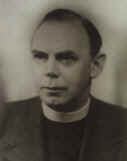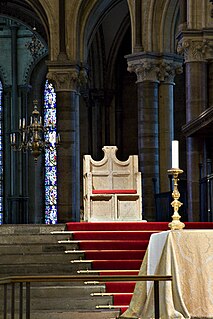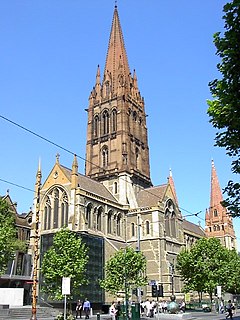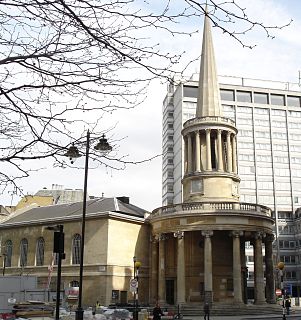This article needs additional citations for verification .(April 2012) (Learn how and when to remove this template message) |
| Part of a series on |
| Anglicanism |
|---|
 |
Ministry and worship |
Background and history |
Central Churchmanship describes those who adhere to the middle way in the Anglican Communion of the Christian religion and other Anglican church bodies, being neither markedly high church/Anglo-Catholic nor low church/evangelical Anglican in their liturgical preferences. The term is used much less frequently than some others. In The Claims of the Church of England, Cyril Garbett, Archbishop of York, uses the term along with Anglo-catholic, Liberal, and Evangelical as a label for schools within the Church of England, but also states:

The Anglican Communion is the third largest Christian communion. Founded in 1867 in London, England, the communion currently has 85 million members within the Church of England and other national and regional churches in full communion. The traditional origins of Anglican doctrines are summarised in the Thirty-nine Articles (1571). The Archbishop of Canterbury in England acts as a focus of unity, recognised as primus inter pares, but does not exercise authority in Anglican provinces outside of the Church of England.

The term "high church" refers to beliefs and practices of ecclesiology, liturgy, and theology, generally with an emphasis on formality and resistance to "modernisation". Although used in connection with various Christian traditions, the term originated in and has been principally associated with the Anglican/Episcopal tradition, where it describes Anglican churches using a number of ritual practices associated in the popular mind with Roman Catholicism. The opposite is low church. Contemporary media discussing Anglican churches tend to prefer evangelical to "low church", and Anglo-Catholic to "high church", though the terms do not exactly correspond. Other contemporary denominations that contain high church wings include some Lutheran, Presbyterian, and Methodist churches.

The term "low church" refers to churches which give relatively little emphasis to ritual, sacraments and the authority of clergy. The term is most often used in a liturgical context.
Within the Anglican Church are Anglo-Catholics, Evangelicals, Liberals and the great mass of English Churchmen who are content to describe themselves as Churchmen without any further label. ( Garbett :13 & 26)
The term came into use in the late nineteenth century when traditional High Churchmen decided to distance themselves from Anglo-Catholicism and Ritualism ( Chadwick :357)). Central Churchmen value both the official liturgies of the Church of England, which they clothe in a moderate amount of ceremony and a characteristically Anglican way of doing theology that is rooted in the Bible and the Creeds of the Early Church, whilst also valuing the contribution made by the English Reformation. In their theological thinking, they steer a middle course between the Anglo-Catholic and Evangelical parties,( MacGrath :112) both of which are perceived as being extreme by Central Churchmen. F. A. Iremonger places William Temple among this group emphasizing that Temple had a firm hold on the articles of the historic creeds and a conviction that what is best in each school of thought within the Church is worth conserving.( Iremonger :494)

Anglo-Catholicism, Anglican Catholicism, or Catholic Anglicanism comprises people, beliefs and practices within Anglicanism that emphasise the Catholic heritage and identity of the various Anglican churches.

The Church of England is the established church of England. The Archbishop of Canterbury is the most senior cleric, although the monarch is the supreme governor. The Church of England is also the mother church of the international Anglican Communion. It traces its history to the Christian church recorded as existing in the Roman province of Britain by the third century, and to the 6th-century Gregorian mission to Kent led by Augustine of Canterbury.
A creed is a statement of the shared beliefs of a religious community in the form of a fixed formula summarizing core tenets.
Perhaps the best known exponent of the Central Churchman position in the twentieth century was Geoffrey Francis Fisher, Archbishop of Canterbury from 1945 to 1961. Many other well-known English bishops, including Robert Stopford, Henry Montgomery Campbell, and Mervyn Haigh also favoured a Central Churchmanship approach, as a way of defusing tensions within their dioceses, and as a way of promoting a so-called "brand image" for the Church of England.

The Archbishop of Canterbury is the senior bishop and principal leader of the Church of England, the symbolic head of the worldwide Anglican Communion and the diocesan bishop of the Diocese of Canterbury. The current archbishop is Justin Welby, who was enthroned at Canterbury Cathedral on 21 March 2013. Welby is the 105th in a line which goes back more than 1400 years to Augustine of Canterbury, the "Apostle to the English", sent from Rome in the year 597. Welby succeeded Rowan Williams.

Robert Wright Stopford, was a British Anglican bishop.

Henry Colville Montgomery Campbell was a Church of England bishop. He was ordained in 1910 and served as vicar or rector in a number of London parishes before being consecrated as a bishop in 1940, holding, successively, the suffragan bishoprics of Willesden and Kensington and the diocesan bishoprics of Guildford and London until his retirement in 1961.
Since the 1970s Central Churchmanship as a distinct school of thought and practice within the Church of England has been in decline. This is mainly due[ dubious ] to the closure or merger of some theological colleges that used to favour the Central position—namely, Wells Theological College, Lincoln Theological College, and Tenbury Wells—and a drift towards theological Liberalism, or Affirming Catholicism in others.

Wells Theological College began operation in 1840 within the Cathedral Close of Wells Cathedral. It was one of several new colleges created in the nineteenth century to cater not just for non-graduates, but for graduates from the old universities who wished to receive specialist clerical training in preparation for ordination into the Church of England. It was founded by Bishop Law.

Lincoln Theological College was a theological college in Lincoln, United Kingdom.
Affirming Catholicism is a movement operating in several provinces of the Anglican Communion, including the UK, Ireland, Canada, and the United States. In the US, the movement is known as Affirming Anglican Catholicism or AAC. The movement represents a liberal strand of Anglo-Catholicism and is particularly noted for holding that Anglo-Catholic belief and practice is compatible with the ordination of women. It also generally supports ordination into the threefold ministry regardless of gender or sexual orientation.







